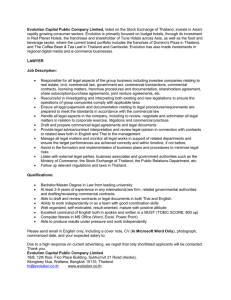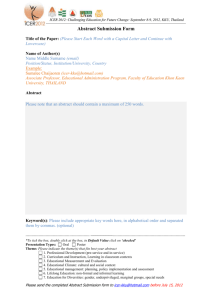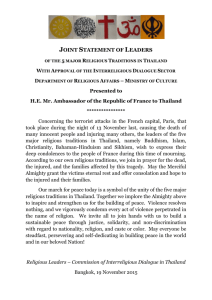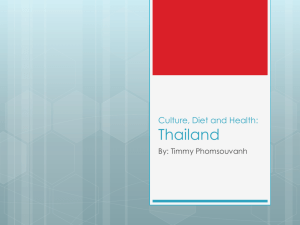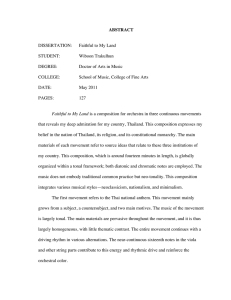LAND COVER CLASSIFICATION AND MONITORING IN NORTHEAST THAILAND
advertisement
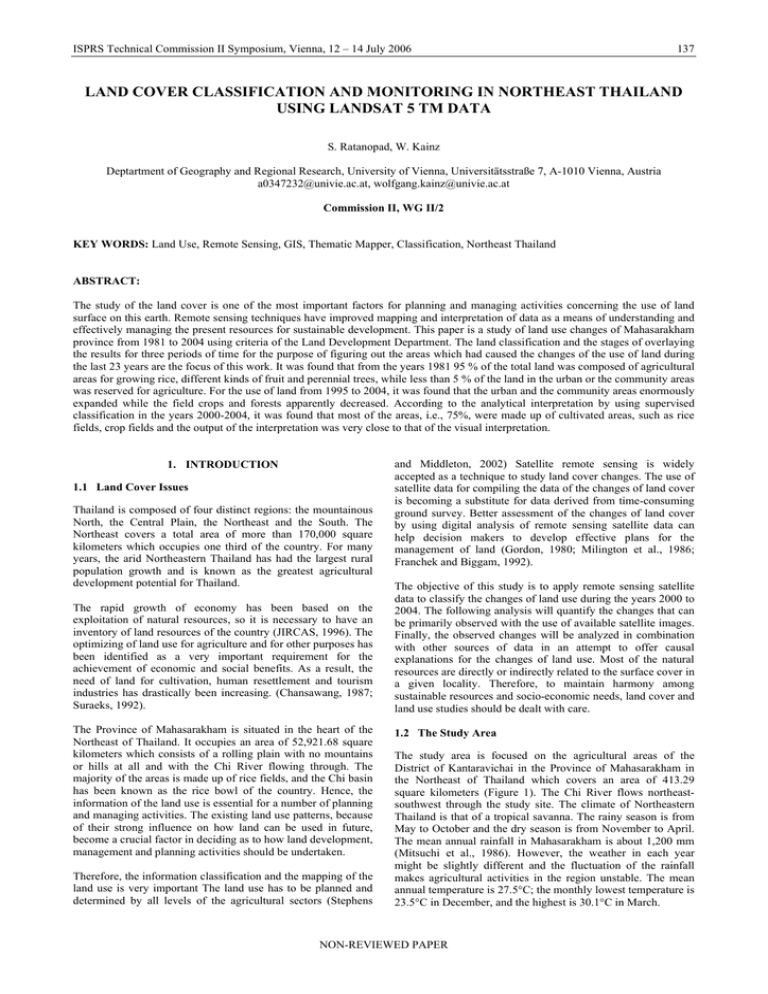
ISPRS Technical Commission II Symposium, Vienna, 12 – 14 July 2006 137 LAND COVER CLASSIFICATION AND MONITORING IN NORTHEAST THAILAND USING LANDSAT 5 TM DATA S. Ratanopad, W. Kainz Deptartment of Geography and Regional Research, University of Vienna, Universitätsstraße 7, A-1010 Vienna, Austria a0347232@univie.ac.at, wolfgang.kainz@univie.ac.at Commission II, WG II/2 KEY WORDS: Land Use, Remote Sensing, GIS, Thematic Mapper, Classification, Northeast Thailand ABSTRACT: The study of the land cover is one of the most important factors for planning and managing activities concerning the use of land surface on this earth. Remote sensing techniques have improved mapping and interpretation of data as a means of understanding and effectively managing the present resources for sustainable development. This paper is a study of land use changes of Mahasarakham province from 1981 to 2004 using criteria of the Land Development Department. The land classification and the stages of overlaying the results for three periods of time for the purpose of figuring out the areas which had caused the changes of the use of land during the last 23 years are the focus of this work. It was found that from the years 1981 95 % of the total land was composed of agricultural areas for growing rice, different kinds of fruit and perennial trees, while less than 5 % of the land in the urban or the community areas was reserved for agriculture. For the use of land from 1995 to 2004, it was found that the urban and the community areas enormously expanded while the field crops and forests apparently decreased. According to the analytical interpretation by using supervised classification in the years 2000-2004, it was found that most of the areas, i.e., 75%, were made up of cultivated areas, such as rice fields, crop fields and the output of the interpretation was very close to that of the visual interpretation. 1. INTRODUCTION 1.1 Land Cover Issues Thailand is composed of four distinct regions: the mountainous North, the Central Plain, the Northeast and the South. The Northeast covers a total area of more than 170,000 square kilometers which occupies one third of the country. For many years, the arid Northeastern Thailand has had the largest rural population growth and is known as the greatest agricultural development potential for Thailand. The rapid growth of economy has been based on the exploitation of natural resources, so it is necessary to have an inventory of land resources of the country (JIRCAS, 1996). The optimizing of land use for agriculture and for other purposes has been identified as a very important requirement for the achievement of economic and social benefits. As a result, the need of land for cultivation, human resettlement and tourism industries has drastically been increasing. (Chansawang, 1987; Suraeks, 1992). The Province of Mahasarakham is situated in the heart of the Northeast of Thailand. It occupies an area of 52,921.68 square kilometers which consists of a rolling plain with no mountains or hills at all and with the Chi River flowing through. The majority of the areas is made up of rice fields, and the Chi basin has been known as the rice bowl of the country. Hence, the information of the land use is essential for a number of planning and managing activities. The existing land use patterns, because of their strong influence on how land can be used in future, become a crucial factor in deciding as to how land development, management and planning activities should be undertaken. Therefore, the information classification and the mapping of the land use is very important The land use has to be planned and determined by all levels of the agricultural sectors (Stephens and Middleton, 2002) Satellite remote sensing is widely accepted as a technique to study land cover changes. The use of satellite data for compiling the data of the changes of land cover is becoming a substitute for data derived from time-consuming ground survey. Better assessment of the changes of land cover by using digital analysis of remote sensing satellite data can help decision makers to develop effective plans for the management of land (Gordon, 1980; Milington et al., 1986; Franchek and Biggam, 1992). The objective of this study is to apply remote sensing satellite data to classify the changes of land use during the years 2000 to 2004. The following analysis will quantify the changes that can be primarily observed with the use of available satellite images. Finally, the observed changes will be analyzed in combination with other sources of data in an attempt to offer causal explanations for the changes of land use. Most of the natural resources are directly or indirectly related to the surface cover in a given locality. Therefore, to maintain harmony among sustainable resources and socio-economic needs, land cover and land use studies should be dealt with care. 1.2 The Study Area The study area is focused on the agricultural areas of the District of Kantaravichai in the Province of Mahasarakham in the Northeast of Thailand which covers an area of 413.29 square kilometers (Figure 1). The Chi River flows northeastsouthwest through the study site. The climate of Northeastern Thailand is that of a tropical savanna. The rainy season is from May to October and the dry season is from November to April. The mean annual rainfall in Mahasarakham is about 1,200 mm (Mitsuchi et al., 1986). However, the weather in each year might be slightly different and the fluctuation of the rainfall makes agricultural activities in the region unstable. The mean annual temperature is 27.5°C; the monthly lowest temperature is 23.5°C in December, and the highest is 30.1°C in March. NON-REVIEWED PAPER 138 International Archives of Photogrammetry, Remote Sensing, and Spatial Information Sciences Vol. XXXVI – Part 2 Figure 1. Study area in Northeastern Thailand 2. METHODOLOGY The image classification procedure is to automatically categorize all pixels according to the statistical properties of the data or according to the spectral signatures in the training set. The approach of two types of the classification of the image data aimed at finding the differences between the classified images of two different dates (Weismiller et al., 1977; Gordon, 1980; Singh, 1989) Supervised classification uses the independent information from spectral reflectance data to define training data for determining classification categories. The approach included the use of Maximum Likelihood by supervised classification with the combination of topographic data using different bands of Landsat 5 TM data in the years 2000 and 2004. The land use classification was conducted by using the output assessment of automated classification by choosing the land sample from the land survey. There were 24 training areas which were used for the supervised classification of this image (Figure 1). These training areas were delineated from a false color composite image generated from combinations of the image bands. To avoid misclassification, these areas must be as homogeneous as possible (Hutchinson, 1982). 2.1 Collection of Ancillary Data A multi- temporal satellite data set observed by a LANDSAT 5 Thematic Mapper (TM) and topographic maps drawn on a 1:50,000 scale were used for the analysis (Table 1). TM is an optical sensor which has 7 multi-spectral bands between visible and infrared radiations. The resolution is 30 meters/pixel. The digital data of land use were produced by the Land Development Department (LDD). The topographic maps were produced by The Thai Royal Survey Department. In this study, the criteria for land use in Thailand are defined by the Land Development Department (Soil Survey and Classification Division, 2002). Table of Data Landsat 5 TM IRC-1S Topographic maps Digital land use Data of observation April 13, 2004 April 20, 2004 March 08, 2000 February 05,2000 January 29,2004 March 11,2000 5641I, II, III, IV 1:50,000 1981 and 1995 Table1. List data 2.2 Methods The study of land use in the years 2000 and 2004 was carried out by using satellite image data which was analyzed and interpreted according to the basis of the land use. The method started with the Landsat 5 TM images which were visibly classified and the IRS-1C image data as well as topographic data were associated with visual interpretation. After that the data had to he tested in the field survey to make sure that all the data were valid. Then the data were corrected and made relevant to the condition of the current use of land. Later, the land use data was compared with the land changes by using the method of overlaying the natural resource change analysis during the years 1981, 1995, 2000 and 2004. Hence, decreasing natural resources and increasing other land cover were identified, located, and evaluated at various dates. The visual interpretation of Landsat 5 TM with 7 bands recorded in the years 2000 and 2004 was carried out and incorporated with the collected ground truth information (Blaser et al., 1992). Figure 2. Showing various steps involved classification 3. RESULTS AND DISCUSSION 3.1 Changes of Land Use during the Years 2000 to 2004 by Using Automated Classification The classification of land use during the years 2000 to 2004 by using the Automated Classification is shown in Figure 3. The classification result from the year 2000 is presented in Table 2. It is important that these results have been found solely based on the visual interpretation of the satellite image while defining the training areas for each class in the classification process. NON-REVIEWED PAPER ISPRS Technical Commission II Symposium, Vienna, 12 – 14 July 2006 Figure 3. Classification land use by supervised classification in 2000 and 2004 NON-REVIEWED PAPER 139 140 International Archives of Photogrammetry, Remote Sensing, and Spatial Information Sciences Vol. XXXVI – Part 2 Land use Type 2000 2004 2000-2004 Correct data 2000 % 100 83 % Area Area % Area % paddy field 270.35 65.41 292.57 70.79 22.22 5.38 village 9.70 2.35 27.20 6.58 17.50 4.23 institutional field crop 42.45 10.27 12.90 3.12 -29.55 -7.15 71 water body 19.44 4.70 10.37 2.51 -9.07 -2.19 100 rangeland 6.12 1.48 9.28 2.25 3.16 0.77 100 orchard 3.43 0.83 0.42 0.10 -3.01 -0.73 70 forest 61.80 14.95 46.58 11.27 -15.22 -3.68 80 salt flat 13.97 3.38 13.97 3.38 0 Total 413.29 100.00 413.29 100.00 Source: Supervised Classification of satellite imagery in 2000 and 2004 Table 2. Classification of land use using Automated Classification Method (area unit square kilometer) Based on the data from the table, it is found that the use of land was quite intermingled. However, these data have been used on the database of each category of the use of land. The images of the rice fields are quite exact because of the correct proportion of the image classification while the dwelling areas were intermingled with the agricultural areas, which were the rice fields and the orchards. However, the geographic information system becomes beneficial in classifying these areas. For the water resource areas, the classification was very accurate according to the correct proportion of the image classification. These data were later tested in the field survey. After the computerized data classification it was found that the land use was quite intermingled. Therefore, other data such as the visual interpretation of the false-color composite image were used to achieve the most benefit. The classification of land use was much clearer, more accurate and very close to the real land use. The rice fields covered 70% of the agricultural areas with 90% validity and it will be used as the database for further study. It was difficult to distinguish burnt agriculture fields from burnt forest land as they became similarly burnt barren areas. These factors have an effect on vegetation status causing reflectance values of land use rather difficult to be compared. However, possible similar nomenclatures were set up according to the physical characteristics despite the different types of land use. 3.2 Changes of Land Use during the Years 1981 to 2004 by using Visual Interpretation The changes of the land use during the three periods of time (1981–1995, 1995–2000 and 2000–2004) were observed by comparing the changes of land use in the overall images in Table 3 and Figures 4 and 5. Forest Thus, in the period of time from 1981 to 1995, the forest cover declined from 6.51 percent to 0.90 percent with an annual loss of approximately 5.61 percent. The period of time from 1995 to 2000 showed a loss rate of 0.38 percent per year. Deciduous forest cover decreased to 0.52 percent in the year 2000 and to 0.81 percent in the year 2004. The total rate of the forest increase during the years 2000 to 2004 was approximately 0.29 percent per year. These figures indicate that the critical problem of deforestation was related to the forest land encroachment, illegal log poaching, charcoal and firewood collection, forest management and corruption. Correct data 2004 % 100 100 70 100 94 100 96 98 Village Settlement The following types of settlement can be distinguished: villages and official institutions. The increase was due to the extension of the villages during the years 1981 to 2004. From the year 1981 to the year 1995 the extension of dwelling areas increased 1.46 percent and 6.37 percent respectively. It is found that the increasing proportion of the dwelling areas from the year 1981 to the year 1995 was approximately 4.91 percent which was considered rapidly soaring because of the fact that there have been education development and expansion so the education institutes such as Mahasarakam University have contributed to the economic and social growth. However, from the year 1995 to the year 2004, the growth rate tended to decline to 6.37 percent, 6.76 percent, and 7.52 percent respectively. Village settlements have crucial impacts on the use of land. In the past, houses were built at a certain range from one another even though they were laid out in a clustery pattern, but now due to the population increase, each house was built in a rather close range. In the past, houses were built to accommodate the livestock underneath at night. Now the underneath of the house is modified and used for human dwelling. Both factors have prevented the livestock from being sheltered under the houses, as farmers have to be with their animals outside the village at night to avoid livestock theft (Simaraks S. et al., 2003). Water Sources Water bodies are located on the boundaries between the paddy fields and the crop fields. Since intensive agriculture was introduced, water bodies have enormously increased from 1.72 percent to 3.90 percent of the total area from the year 1981 to the year 2004. The water sources in the Northeast of Thailand have a great effect on the human life as a matter of fact that most the Northeastern parts of Thailand have the most serious risk of drought and famine in Thailand. Therefore the government has been trying to help build dike dams, and dig up canals to irrigate water into the agricultural areas. Paddy Fields The paddy upgrading has immensely boosted the rice production during the two decades. Because of the well-known reputation of the Thai rice, and because of being the main export, paddy fields have steadily been expanding during the years 1981 to 2000. Paddy fields have a share of approximately 73.98 percent in the year 1981, 79.14 percent in the year 1995, and 79.85 percent in the year 2000 of the total cultivated areas. NON-REVIEWED PAPER ISPRS Technical Commission II Symposium, Vienna, 12 – 14 July 2006 Figure 4. Classification of land use during 1981 and 1975 NON-REVIEWED PAPER 141 142 International Archives of Photogrammetry, Remote Sensing, and Spatial Information Sciences Vol. XXXVI – Part 2 Figure 5. Classification of land use during 2000 and 2004 NON-REVIEWED PAPER ISPRS Technical Commission II Symposium, Vienna, 12 – 14 July 2006 1981 1995 2000 143 2004 1981 – 1995 1995 – 2000 2000 – 2004 Land use Type Area % Area % Area % Area % Area % Area % Area paddy field 305.77 73.98 327.1 79.14 330.01 79.85 315.32 76.30 -21.31 -5.16 -2.93 -0.71 14.69 3.55 village 5.98 1.45 22.38 5.42 24.01 5.81 26.94 6.52 -16.40 -3.97 -1.63 -0.39 -2.93 -0.71 institutional 0.06 0.01 3.93 0.95 3.94 0.95 4.15 1.00 -3.87 -0.94 -0.01 0.00 -0.21 -0.05 -0.46 field crop % 36.95 8.94 31.11 7.53 23.89 5.78 25.79 6.24 5.84 1.41 7.22 1.75 -1.90 7.1 1.72 13.43 3.25 15.53 3.76 16.10 3.90 -6.33 -1.53 -2.1 -0.51 -0.57 -0.14 26.79 6.48 6.95 1.68 9.34 2.26 15.43 3.73 19.84 4.80 -2.39 -0.58 -6.09 -1.47 orchard 0.79 0.19 0.67 0.16 4.43 1.07 5.61 1.36 0.12 0.03 -3.76 -0.91 -1.18 -0.29 forest 26.9 6.51 3.73 0.90 2.14 0.52 3.33 0.81 23.17 5.61 1.59 0.38 -1.19 -0.29 perennial 2.95 0.71 4.01 0.97 0 0.00 0.00 0.00 -1.06 -0.26 4.01 0.97 0.00 0.00 0 0.00 0 0.00 0 0.00 0.61 0.15 0.00 0.00 0 0.00 -0.61 -0.15 413.29 100.00 413.29 100.00 413.29 100.00 413.29 100.00 water body rangeland salt flat Total Source: Visual interpretation of satellite imagery in 2000 and 2004. Land use data 1981 and 1995 by the Land Development Department. Table 3. Change of the types of land use during the year 1981-2004 (area unit square kilometers) Rice has been continuously and increasingly exported to different parts of the world for the last two decades despite the rival rice producers in other Asian countries. The use of modern inputs and farm machinery has also contributed to the significant increase of rice production. Basically, paddy fields are located near the dwelling areas. During the years 2000–2004 rice fields covered 76.30 percent of the total area, but now these areas are threatened by the housing development projects because of the population growth and the need of residential accommodations. Orchards In the past, fruit gardeners used a lot of chemical fertilizers causing poor soil in later years and fruit trees no longer yielded fruit, so the gardeners have had to grow different kinds of fruit in the same orchards, which are called mixed fruit gardens. In the period of time from 1981 to 1995, the orchards declined from 0.19 percent to 0.16 percent with an annual loss of approximately 0.03 percent. The total rate of the orchards increase during the years 1995 to 2004 was approximately 1.12 percent per year Field crops Field crops consist of thee main kinds of plants: sugar cane, cassava and chili. These crops have been widely grown in the upland and highland valleys. They are still valuable crops of the villages. The cultivated areas rose up from the year 2000 to 0.464 in the year 2004. However, in the years 1981, 1995, and 2000, they gradually dropped to 8.94 percent, 7.53 percent and 5.78 percent, respectively. Cassava has become a favorite field crop as it can endure the natural drought of the area and because of His Majesty, King Bhumibhol’s sufficient economic project, villagers have been growing it for their daily consumption as well as for selling. Rangeland These kinds of plants, such as grass, shrub and lotuses, were widely found in the wet basins, which were used as pastures for the livestock. From the years 1981 to 1995, the pastures covered 6.48 % and 1.68% of the land respectively, but later it dropped down to 4.80%. However, during the years 1995 to 2004, it rose up to 2.05% because the government had designated and developed these areas to be tourist attractions or national parks for not only general people but also tourists. Perennial This kind of plants, which are largely composed of eucalyptus, was found in the years 1981 and 1995 about 0.71% and 0.97%, respectively. It was found that the areas of growing eucalyptus were expanded because the government had promoted growing them for exporting overseas, but the projects were fruitless as it was proved to have made the land barren and arid. Even worse, it resulted in the rapid degradation of the soil, and it also cost a lot of money to grow this kind of plants, so it was not widely planted. As a result, it was not commonly seen in the years 2000 to 2004. Salt Flat The salt fields covered very small areas which were about 0.15% in the year 2004 because the salt farms had resulted in a serious impact on the environment. For example, it polluted the natural bodies of water such as canals and streams and made some areas become saline or it caused a salt-lick, which had caused a dangerous problem for the land which has been reserved for agricultural cultivation. As a result, agriculture is considered the most important source of the livelihood of almost all of the people in Thailand, particularly the people in the Northeast. Besides the mentioned field crops, other crops such as papayas, mangoes, bananas are grown for their subsistence as well as for selling. Unfortunately, the improper use of chemical fertilizers has had an unexpected impact on the soil fertility, causing the crop yield to decline, and because of the rapid population growth and the need for resident accommodation, most of cultivated areas have been changed to dwelling sites. 4. CONCLUSION The changes of the land use in the District of Kantarawichai in the Province of Mahasarakham have been historically analyzed. With the help of semi-structure interviews and historical data sources, it has been made possible to bring the land use history back to the early 1950s. The patterns and the changes of land use during the past two decades have been analyzed by using two different types of remote sensing satellite data. Land degradation, flood and drought have caused the increase of the demand for water. The rapid population growth has had a great relevance to the agricultural production which has been the main source of income up to now. The current status of land NON-REVIEWED PAPER 144 International Archives of Photogrammetry, Remote Sensing, and Spatial Information Sciences Vol. XXXVI – Part 2 use is that the forest and paddy field areas have been reduced and that the urban areas have been rapidly expanded, resulting in the changes of land use from the agricultural purposes to the industrial purposes. These types of land use have physical and geographical connection in common. As one area increases in one type of use, it will be associated with an area decrease in another land use category. Surareks, V. 1992. Land use change in Thailand: its impacts on environmental. Proceeding of Asians Symposium on global environmental change, Tokyo, 102 December. Center for global environmental agency of Japan. Weismiller, R.A., Kristof, S.J., Scholz, D.K., Anuta, P.E., and Momen, S.A., 1977. Change detection in coastal zone environments, Photogrammetric Engineering and Remote Sensing, Vol. 43, pp. 1533-1539. REFERENCES Blaser, T.J., Lyon, R.J. and Lank, K., 1992. Updating a Land Planning Database from Landsat 5 Thematic Mapper Data: Geographic Information Systems and Mapping Practices and Standards, ASTM STP 1126, A.I. Johnson, C.B. Pettersson and J. Fulton, Eds., American Society for Testing and Materials, Philadelphia, pp.132-154. Chansawang, A., 1987. Local Social Development in Thailand: The Ban Tako Experience: Regional Development, Vol. II, pp. 122-150. ACKNOWLEDGMENT The first author would like to give special thanks to all the staff of the Cartography and Geo-information Group at the Department of Geography and Regional Research at the University of Vienna for their continual and painstaking support. My heartfelt thanks also go the Land Development Department of Thailand for the valuable data collection. And above all, without the financial assistance from the Thai Government Fund, this work would not have been completed. Franchek, R.J. and Biggam, P.F., 1992. Using USDA Soil Conservation Service County Soils Data with a Geographic Information System: Geographic Information Systems and Mapping Practices and Standards, ASTM STP 1126, A.I. Johnson, C.B. Pettersson and J. Fulton, Eds., American Society for Testing and Materials, Philadelphia, pp. 115-121. Gordon, S., 1980. Utilizing Landsat imagery to monitor land use change: A case study in Ohio. Remote Sensing of Environment, 9, pp. 189-196. Hutchinson, J., 1993. Class and state power in the Philippines. In Hewison, K., Robison, R. and Rodan, G. (Eds) Southeast Asia in the 1990s: authoritarianism, democracy and capitalism. Allen and Unwin, St. Leonards, pp. 193-212. JICA, 1996. Research on development of technology to produce images for soil classification by remote sensing in connection with Northeast Thailand Agricultural Development Research Project. JICA ADT-JR-86-46. Milington, A.C., Jones, A.R., Quarmby, N.A. and Townsend, J.R.G., 1986. Monitoring geomorphological processes in desertmarginal environments using multitemporal satellite imagery. Proceedings of the International Symposium on Remote Sensing for Resource Development and Environmental Management, A.A. Balkema. Mitsuchi, M., Wichatidit, P. and Jeungnijmirund,S., 1986. Outline of soils of the Northeast plateau, Thailand. Technical Paper No.1. ADRC. Simaraks, S. Subhadhira, S., Srila, S., 2003. The shift role of large livestock in Northeast Thailand. Southeast Asian Studies, Vol. 41, No. 3, December, pp. 316-325. Singh, A., 1989. Digital change detection techniques using remotely sensed data, International Journal of Remote Sensing, Vol. 10, pp.989-1003. Soil Survey and Classification Division, LDD, 2002. Manual for soil suitability classification for economic crop in Thailand. Technical Paper No.453 (ISBN 974-7723-58-1). Stephens, W., Middleton, T., 2002. Crop-Soil Simulation Models: Application in Developing Countries. Cranfield University, UK. NON-REVIEWED PAPER

